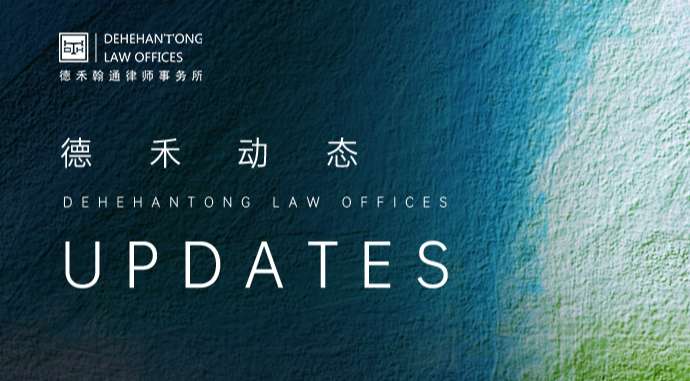An In-Depth Analysis of the "Interpretation (II) by the Supreme People's Court on Legal Issues Concerning Labor Dispute Cases" and Compliance Guidelines for Employers
01 Introduction
The Interpretation of the Supreme People's Court on the Application of Law in the Trial of Labor Dispute Cases (II) (hereinafter referred to as "Interpretation II") has undergone multiple rounds of research, argumentation and opinion collection, and will come into effect on September 1, 2025.
The highlight of "Interpretation II" lies in its focus on areas with a high incidence of labor disputes, establishing the "penetration" principle to clarify the employment responsibility subjects, detailing rules such as fixed-term contracts and non-compete restrictions, strengthening the procedural requirements for dismissal management, and highlighting the principle of "substance over form" in judicial review, providing clearer guidance for employers to comply with employment regulations.
02 Legal Application of the "Penetration" Principle (Articles 1 to 3)
Interpretation II clearly establishes the "penetration" principle, whose core purpose is to accurately define the actual employment responsibility subject and prevent employers from evading legal responsibility through complex employment structures.
Article 1 and Article 2 specifically stipulate that when the project owner subcontracts or assigns its business to an entity without legal business qualifications, or when an entity without the corresponding qualifications conducts business activities externally through "affiliation" with a unit with legal business qualifications, The contractor or the affiliated entity with legal business qualifications will be legally recognized as the entity bearing the main responsibility for employment. The legislative intent of this regulation is to ensure that in aspects such as the payment of labor remuneration and the implementation of work-related injury insurance benefits, the responsibility is borne by entities with legal status and sufficient financial capacity, thereby safeguarding the legitimate rights and interests of workers.
Article 3 specifically regulates the "group employment" or "affiliated company employment" model, clearly defining the criteria for determining labor relations as "priority given to those who have signed written labor contracts". In the absence of a contract, it takes into account "management behavior + comprehensive factors". Specifically, when handling such cases, it is not only necessary to review the wage payment entity and the social security contribution entity from a formal perspective, but also to comprehensively examine the actual entity that manages the workers, including key factors such as who is responsible for allocating work tasks, who controls working hours, and who implements performance evaluations, in order to determine the true employer. Even to clarify the issue of employment responsibility sharing among affiliated companies.
The above-mentioned rule adjustments closely link labor law compliance risks with corporate governance risks. The aim is to specifically regulate the business outsourcing model that relies on low-cost and questionable third parties, as well as the behavior of confusing labor relations and evading legal responsibilities through complex structures, so as to prompt enterprises to standardize their employment structure and enhance their compliance management level.
03 Regulation of Fixed-term Labor Contracts (Articles 6 to 11)
Interpretation II has made a series of targeted provisions in response to the phenomenon in practice where some employers abuse fixed-term labor contracts and infringe upon the rights and interests of workers, further strengthening the regulation of fixed-term labor contracts.
1. Expand the definition of "consecutive conclusion" (Article 10) : This article clearly stipulates that four situations will be counted as the number of times of "consecutive conclusion of two fixed-term labor contracts". These four situations are respectively:
(1) Where both parties negotiate to extend the term of the labor contract, and the cumulative extension period is more than one year, and the extended labor contract has expired;
(2) Where a labor contract stipulates that the contract will be automatically extended upon its expiration and the extended labor contract has already expired;
(3) Where a worker works at the original workplace or position not due to his or her own reasons, and the employer re-enters into a labor contract with the worker by changing the contracting parties, but still manages the worker, and such labor contract has expired. For instance, if an employer, after the expiration of a labor contract with an employee, to avoid signing an open-ended labor contract, asks the employee to first sign a short-term labor contract with an affiliated company and then transfer the contract back to the original company, such behavior may be regarded as evasive behavior, and the number of related contracts will be accumulated.
(4) Where an employer re-enters into a fixed-term labor contract with an employee through other evasive acts that violate the principle of good faith, and such labor contract has already expired.
2. Detailed penalties for double wages (Articles 6 to 9) : It is clearly stipulated that if an employer fails to enter into a written labor contract or an open-ended labor contract with an employee in accordance with the law, the double wages to be paid shall be calculated on a monthly basis. If the period is less than one month, it shall be calculated based on the actual working days of that month. At the same time, it is stipulated that employers may defend themselves under specific circumstances. For instance, if a labor contract cannot be concluded in a timely manner due to force majeure, or if a labor contract fails to be concluded due to the employee's own fault, such as refusing to provide necessary signing information, the employer may be exempted from the responsibility of paying double wages. Article 8 clearly stipulates that the extension of a labor contract in accordance with Article 42 of the Labor Contract Law and Article 19 of the Trade Union Law, as well as the extension due to the expiration of the service period, do not fall under the category of not having concluded a written labor contract. Article 9 also stipulates that in cases where the legal conditions are met and an open-ended labor contract is "deemed" to have been concluded, for instance, if an employer fails to enter into a written labor contract with an employee within one year from the date of employment, the employee may request the employer to sign a written open-ended labor contract in a timely manner, but shall not claim double wages for the period during which the employer fails to sign the contract in a timely manner.
04 Balance of Interests in Employee Turnover: Service Period and Non-compete Restrictions
(1) Compensation for Breach of Service Period (Article 12)
Article 12 stipulates a clear mechanism for calculating losses and compensation when an employer and an employee have agreed on a service period (usually linked to the employer's provision of special benefits such as housing, household registration qualifications, and specialized training for the employee), and the employee leaves the job before the expiration of the service period. According to this regulation, employers are not allowed to directly apply the high penalty clause agreed upon in advance by both parties. When courts hear such cases, they will comprehensively consider the actual losses of the employers, such as the training expenses and housing subsidies paid for the employees. The years of service that the employee has fulfilled; The actual cost of special benefits; The compensation amount shall be adjusted proportionally based on factors such as the degree of fault of both parties regarding the employee's resignation. This regulation not only regulates the behavior of employers restricting the reasonable mobility of employees by setting excessively high liquidated damages, but also requires employees who violate integrity and "fail to show up" in advance to bear corresponding compensation liability, balancing the interests between employers and employees.
(2) Determination of the Validity of Non-compete Agreements (Articles 13 and 14)
1.Substantive validity Test (Article 13) : This article stipulates that the validity of a non-compete agreement must be premised on the employee's actual knowledge or access to the employer's trade secrets or confidential matters related to intellectual property rights. This means that after an employer signs a non-compete agreement with an employee, if the employee asserts their rights due to violation of the agreement, the employer needs to bear the burden of proof and provide sufficient evidence to prove that the employee did indeed come into contact with the employer's trade secrets and confidential matters related to intellectual property rights during the employment period. If the employer fails to provide evidence to prove this point, the binding force of the non-compete agreement will not be recognized by the court.
2.Compatibility Review (Article 13, Paragraph 2) : When the court reviews a non-compete agreement, it will compare the scope, geographical area and duration of the non-compete restrictions stipulated in the agreement with the nature and scope of the trade secrets that the employee has access to. If it is found that a certain part of the content is "incompatible" with the trade secrets that the employee has access to and exceeds the necessary limit for protecting the trade secrets, the court may determine that such part of the content is invalid.
The above rules require employers to avoid abusing non-compete restrictions and, when signing non-compete agreements, refrain from using one-size-fits-all terms. Instead, they should tailor the scope, geographical location and duration of non-compete restrictions based on the nature of the employee's position, job content and specific trade secrets they have access to, to ensure the validity and enforceability of the agreement.
05 Procedural Requirements and Consequences of Dismissal Management
(1) Circumstances Where a labor contract cannot be continued to be performed (Article 16)
After an employer illegally terminates a labor contract, according to the law, restoring the labor relationship is the default legal remedy. This "Interpretation II" clearly stipulates in which specific circumstances the court will determine that "the labor contract cannot be continued to be performed", and thereby order the employer to pay compensation instead of restoring the labor relationship.
Article 16 specifically lists six circumstances that can be recognized as "the labor contract cannot be continued to be performed", including when the labor contract expires and there are no circumstances that should be renewed or extended in accordance with the law; Where the employer has gone through bankruptcy liquidation, had its business license revoked, been ordered to close down, been dissolved, or has decided to dissolve in advance; Where a worker begins to enjoy the basic old-age insurance benefits in accordance with the law; The employee has already been employed by another employer, and the new labor relationship will have a substantial impact on the continued performance of the original labor relationship. And other circumstances where it is objectively impossible to restore the labor relationship.
Among them, for cases where a worker has established a labor relationship with another employer, if the employer claims that the labor contract cannot be continued, it needs to provide evidence to prove that the worker's work in the new unit has had a "serious impact" on the tasks of the original unit, such as causing the loss of the core business of the original unit or the leakage of trade secrets, etc. Or it can be proved that the employer has written to the employee to request the termination of the labor relationship with the new employer, but the employee refuses. Only when one of the above conditions is met may the court determine that the labor contract cannot be continued to be performed.
(2) Pre-Departure Occupational Health Examination (Article 17)
For workers engaged in operations with occupational disease hazards, such as production workers in the chemical industry and miners in the coal mining industry, conducting pre-departure occupational health examinations is a legal prerequisite for employers to dismiss such workers. The purpose of this regulation is to protect the physical health of workers and promptly identify potential occupational disease risks. If an employer terminates a labor contract without conducting a pre-departure occupational health examination for the employee as required, the employee has the right to request the continuation of the labor contract, and the court should support this.
Similar to the correction procedure that "one party should notify the trade union before unilateral termination", this "Interpretation II" also gives employers the opportunity to correct the pre-employment physical examination. In two circumstances, the responsibility can be exempted: first, the pre-employment occupational health examination is completed before the conclusion of the first-instance court debate, and the examination results show that the employee has no occupational disease or suspected occupational disease. Second, it can be proved that the employee refuses to undergo the pre-departure occupational health examination without a valid reason. For instance, the employer has already notified the employee in writing to take the examination, but the employee refuses to cooperate without a valid reason and signs to confirm on the relevant written materials.
(3) Calculation of Wages during the Period of Resuming Performance (Article 18)
When a court orders an employer to resume the performance of a labor contract with an employee, the employee's salary during the period from the date of dismissal to the day before the resumption of performance breaks through the current judicial practice in Shanghai. To prevent employees from being negligent in exercising their rights, the starting date of the salary during the resumption period in the Shanghai area has always been "the date when the employee applies for arbitration". Since the implementation of the "Interpretation II", The Shanghai area will also follow the mainstream view across the country, and the salary during the recovery period will be calculated from the date of dismissal.
Regarding the wage standards during the recovery period, they should be paid by the employer in accordance with the "normal labor wage standards" of the workers. The "normal labor wage standard" here usually includes fixed income items such as the basic salary, position salary and fixed allowances of workers, and does not include floating items related to work performance and working hours such as overtime pay, performance bonuses and year-end bonuses. However, it should be noted in the Shanghai area that Article 23 of the "Measures for the Payment of Wages by Enterprises in Shanghai" stipulates that the wage standard during the recovery period is the average monthly wage of the employee in the 12 months prior to the termination of the labor contract, which is higher than the requirements of the "Interpretation II".
At the same time, this article puts forward the principle of "fault sharing", which coincides with the second half of Article 23 of the "Measures for the Payment of Wages by Enterprises in Shanghai", meaning that if the employee is at fault for being dismissed but the employer's dismissal procedure does not comply with the law, then the court may, based on the degree of the employee's fault, proportionally reduce the wages that the employer should make up for.
06 List of Compliance Action Plans for Employers
For employers, the implementation of "Interpretation II" will have an all-round impact. This means that employers need to conduct a comprehensive review of their current human resource policies, meticulously examine the terms of labor contracts, evaluate the compliance of agreements signed with suppliers, and standardize and optimize the employee termination process. Only in this way can they effectively identify new legal risks arising from the implementation of judicial interpretations.
At the same time, based on the patterns of past judicial practice, the strengthening of judicial review standards is often accompanied by an increase in the intensity of relevant administrative law enforcement. The labor administrative department may, in accordance with the standards stipulated in the "Interpretation II", intensify the supervision over employers' labor employment. Therefore, the compliance demands of employers are particularly urgent.
It is worth noting that the official text of the "Interpretation II" has removed several controversial provisions from the draft for public comment, such as "Whether equity incentives fall under labor disputes", "the time limit for arbitration of wages for unused annual leave", and "the rights and interests of over-aged workers". This not only leaves some room for exploration in practice but also reminds employers to continuously pay attention to the subsequent judicial practice's determination tendencies on related issues. To deal with potential disputes more comprehensively.
-
Prev:The plaintiff's shareholding requirements in a derivative lawsuit of a California limited liability company
-
Next:Interview with a Figure | From the Prosecution Bench to the Defense Table: Guarding the Initial Intention of the Rule of Law through Legal Interpretation and Reasoning - Criminal Defense Lawyer Wang Guan















